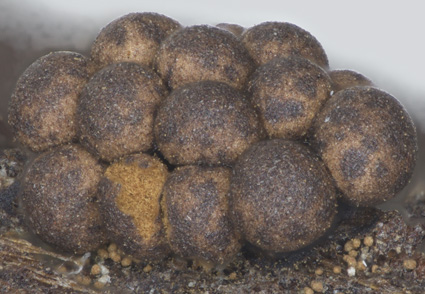Abstract
A new species of bright-spored myxomycete, Trichia insularis, is described in detail and illustrated with light and scanning electron microscope photographs. This species appeared in a moist chamber culture on the acidic bark of Cryptomeria japonica collected in 2006 on La Réunion Island in the Indian Ocean. The species is part of a complex of closely related species of Trichia that includes T. acetocorticola, T. nubila, and T. pinicola. All of these share the distinctive secondary ornamentation of the capillitial threads that consists of longitudinal thin ridges. However, Trichia insularis differs from all previously described species of Trichia by a unique combination of morphological characters and it also has unique substitutions in its nrSSU, EF1α and mtSSU sequences.
References
- Adamonyte, G., Stephenson, S.L., Michaud, A., Seraoui, E.H., Meyer, M., Novozhilov, Yu.K. & Krivomaz, T. (2011) Myxomycete species diversity on the island of La Réunion (Indian Ocean). Nova Hedwigia 92: 523–549. https://doi.org/10.1127/0029-5035/2011/0092-0523
- Bortnikov, F.M., Bortnikova, N.A., Gmoshinskiy, V.I., Prikhodko, I.S. & Novozhilov, Yu.K. (2023) Additions to Trichia botrytis complex (Myxomycetes): 9 new species. Botanica Pacifica 12: 81–119. https://doi.org/10.17581/bp.2023.12s03
- Feng, Y. & Schnittler, M. (2015) Sex or no sex? Group I introns and independent marker genes reveal the existence of three sexual but reproductively isolated biospecies in Trichia varia (Myxomycetes). Organisms Diversity & Evolution 15 (4): 631–650. https://doi.org/10.1007/s13127-015-0230-x
- Fiore-Donno, A.M., Nikolaev, S.I., Nelson, M., Pawlowski, J., Cavalier-Smith, T. & Baldauf, S.L. (2010) Deep phylogeny and evolution of slime moulds (Mycetozoa). Protist 161 (1): 55–70. https://doi.org/10.1016/j.protis.2009.05.002
- Fiore-Donno, A.M., Clissmann, F., Meyer, M., Schnittler, M. & Cavalier-Smith, T. (2013) Two-gene phylogeny of bright-spored Myxomycetes (slime moulds, superorder Lucisporidia). PLoS ONE 8 (5): e62586. https://doi.org/10.1371/journal.pone.0062586
- García-Martín, J.M., Zamora, J.C. & Lado, C. (2023) Multigene phylogeny of the order Physarales (Myxomycetes, Amoebozoa): shedding light on the dark-spored clade. Persoonia 51: 89–124. https://doi.org/10.3767/persoonia.2023.51.02
- Hoang, D.T., Chernomor, O., von Haeseler, A., Minh, B.Q. & Vinh, L.S. (2018) UFBoot2: improving the ultrafast bootstrap approximation. Molecular Biology and Evolution 35 (2): 518–522. https://doi.org/10.1093/molbev/msx281
- Huelsenbeck, J.P. & Ronquist, F. (2001) MrBayes: Bayesian inference of phylogeny. Bioinformatics 17 (8): 754–755. https://doi.org/10.1093/bioinformatics/17.8.754
- Kalyaanamoorthy, S., Minh, B.Q., Wong, T.K.F., von Haeseler, A. & Jermiin, L.S. (2017) ModelFinder: fast model selection for accurate phylogenetic estimates. Nature Methods 14: 587–589. https://doi.org/10.1038/nmeth.4285
- Katoh, K. & Standley, D.M. (2013) MAFFT multiple sequence alignment software version 7: improvements in performance and usability. Molecular Biology and Evolution 30 (4): 772–780. https://doi.org/10.1093/molbev/mst010
- Katoh, K., Rozewicki, J. & Yamada, K.D. (2019) MAFFT online service: multiple sequence alignment, interactive sequence choice and visualization. Briefings in Bioinformatics 20 (4): 1160–1166. https://doi.org/10.1093/bib/bbx108
- Lado, C., Treviño-Zevallos, I., García-Martín, J.M. & Wrigley de Basanta, D. (2022) Diachea mitchellii: a new myxomycete species from high elevation forests in the tropical Andes of Peru. Mycologia 114 (4): 798–811. https://doi.org/10.1080/00275514.2022.2072140
- Leontyev, D., Ishchenko, Yu. & Schnittler, M. (2023) Fifteen new species from the myxomycete genus Lycogala. Mycologia 115: 524–560. https://doi.org/10.1080/00275514.2023.2199109
- Miller, M.A., Pfeiffer, W. & Schwartz, T. (2010) Creating the CIPRES Science Gateway for inference of large phylogenetic trees. In: Gateway Computing environments Workshop (GCe). IEEE, New Orleans, pp. 1–8. https://doi.org/10.1109/GCE.2010.5676129
- Nguyen, L.T., Schmidt, H.A., von Haeseler, A. & Minh, B.Q. (2015) IQ-TREE: a fast and effective stochastic algorithm for estimating maximum-likelihood phylogenies. Molecular Biology and Evolution 32 (1): 268–274. https://doi.org/10.1093/molbev/msu300
- Okonechnikov, K., Golosova, O., Fursov, M. & the UGENE team (2012) Unipro UGENE: a unified bioinformatics toolkit. Bioinformatics 28 (8): 1166–1167. https://doi.org/10.1093/bioinformatics/bts091
- Prikhodko, I.S., Shchepin, O.N., Bortnikova, N.A., Novozhilov, Yu.K., Gmoshinskiy, V.I., Moreno, G., López-Villalba, Á., Stephenson, S.L. & Schnittler, M. (2023) A three-gene phylogeny supports taxonomic rearrangements in the family Didymiaceae (Myxomycetes). Mycological Progress 22: art. 11. https://doi.org/10.1007/S11557-022-01858-1
- Rambaut, A., Drummond, A.J., Xie, D., Baele, G. & Suchard, M.A. (2018) Posterior summarization in Bayesian phylogenetics using Tracer 1.7. Systematic Biology 67 (5): 901–904. https://doi.org/10.1093/sysbio/syy032
- Ronikier, A., García-Cunchillos, I., Janik, P. & Lado, C. (2020) Nivicolous Trichiales from the austral Andes: unexpected diversity including two new species. Mycologia 112 (4): 753–780. https://doi.org/10.1080/00275514.2020.1759978
- Ronikier, A., Janik, P., de Haan, M., Kuhnt, A. & Zankowicz, M. (2022) Importance of type specimen study for understanding genus boundaries—taxonomic clarifications in Lepidoderma based on integrative taxonomy approach leading to resurrection of the old genus Polyschismium. Mycologia 114: 1008–1031. https://doi.org/10.1080/00275514.2022.2109914
- Vences, M., Patmanidis, S., Kharchev, V. & Renner, S.S. (2022) Concatenator, a user-friendly program to concatenate DNA sequences, implementing graphical user interfaces for MAFFT and FastTree. Bioinformatics Advances 2 (1): 1–4. https://doi.org/10.1093/bioadv/vbac050
- Wrigley de Basanta, D., Estrada-Torres, A., García-Cunchillos, I., Cano Echevarría, A. & Lado, C. (2017) Didymium azorellae, a new myxomycete from cushion plants of cold arid areas of South America. Mycologia 109 (6): 993–1002. https://doi.org/10.1080/00275514.2018.1426925


